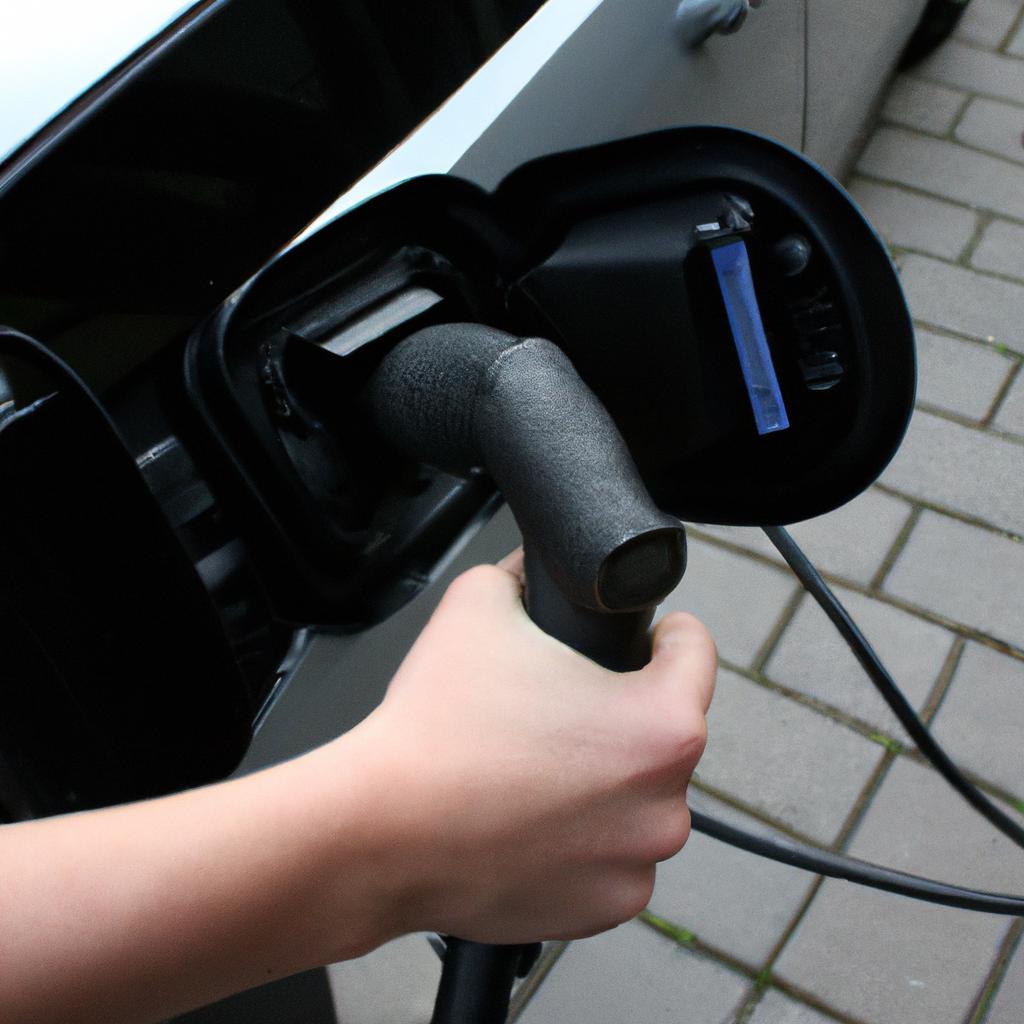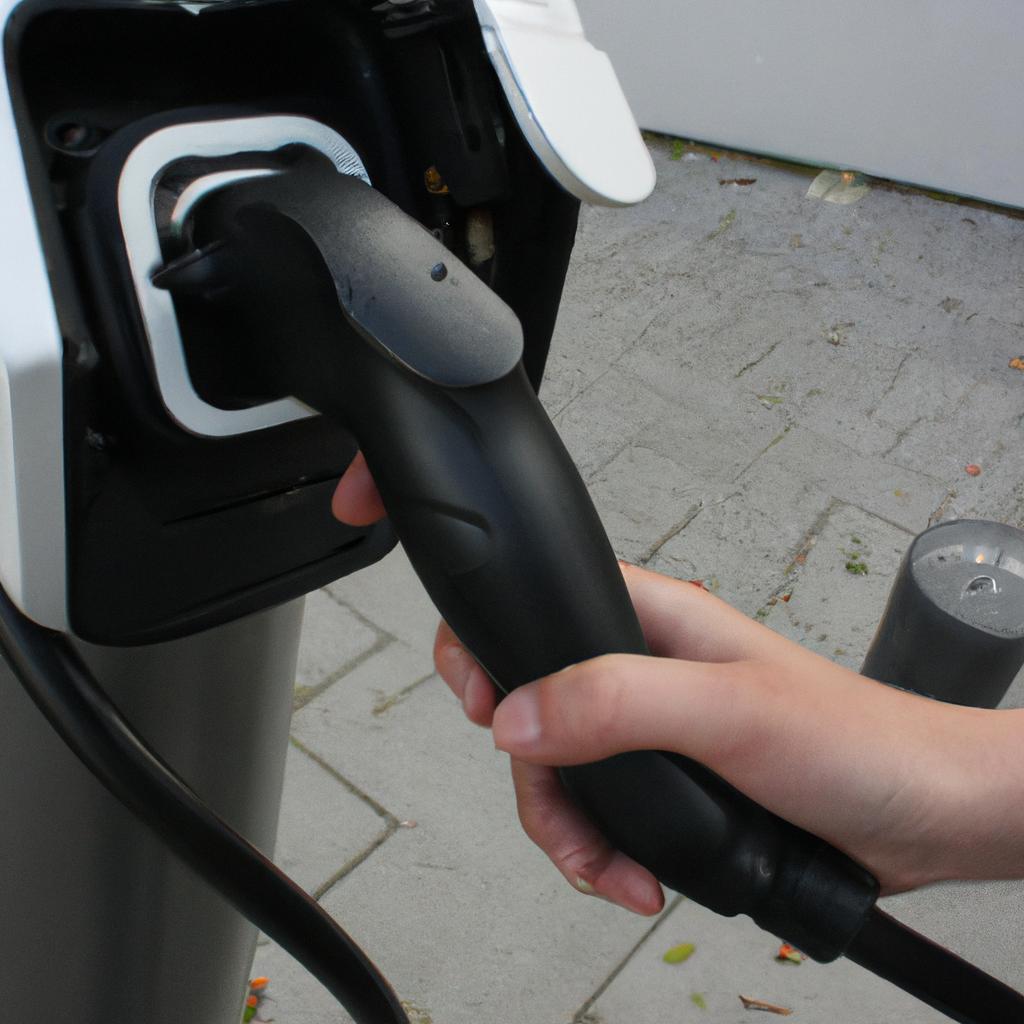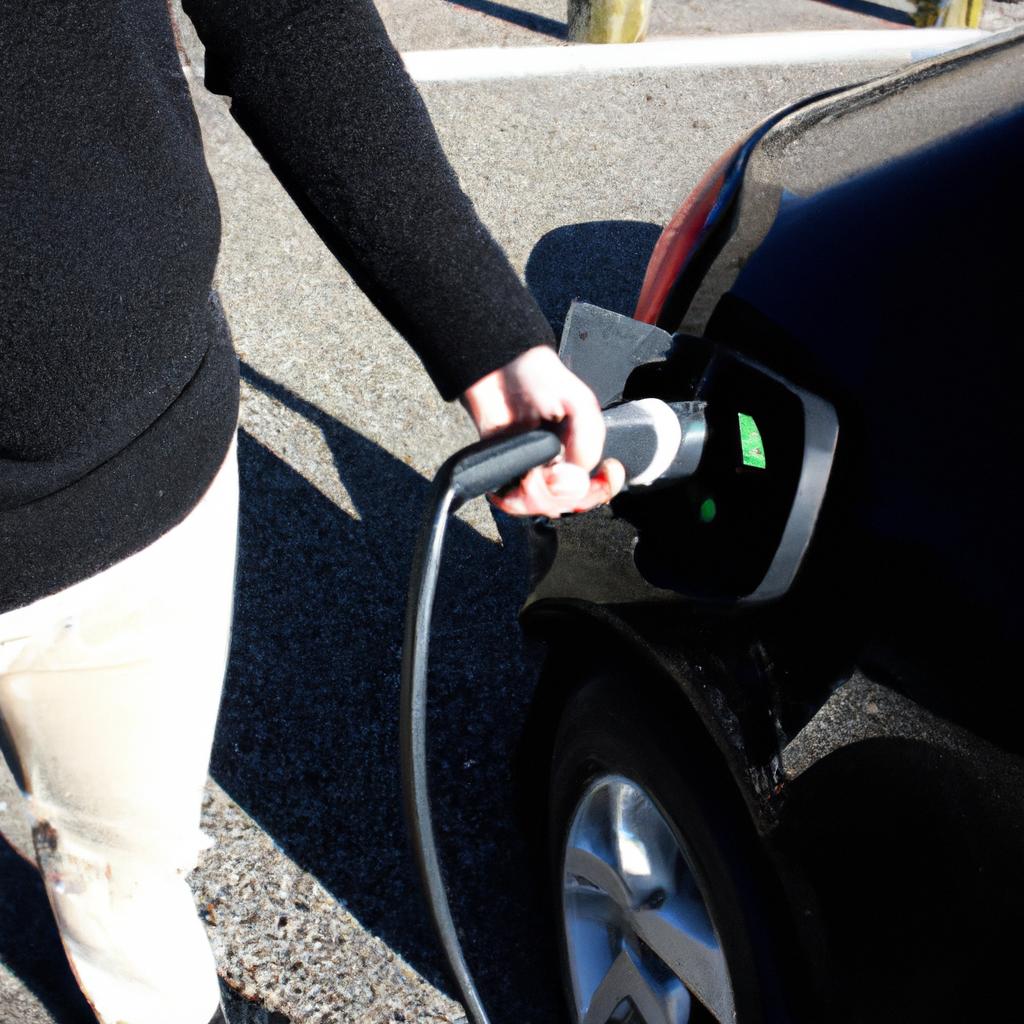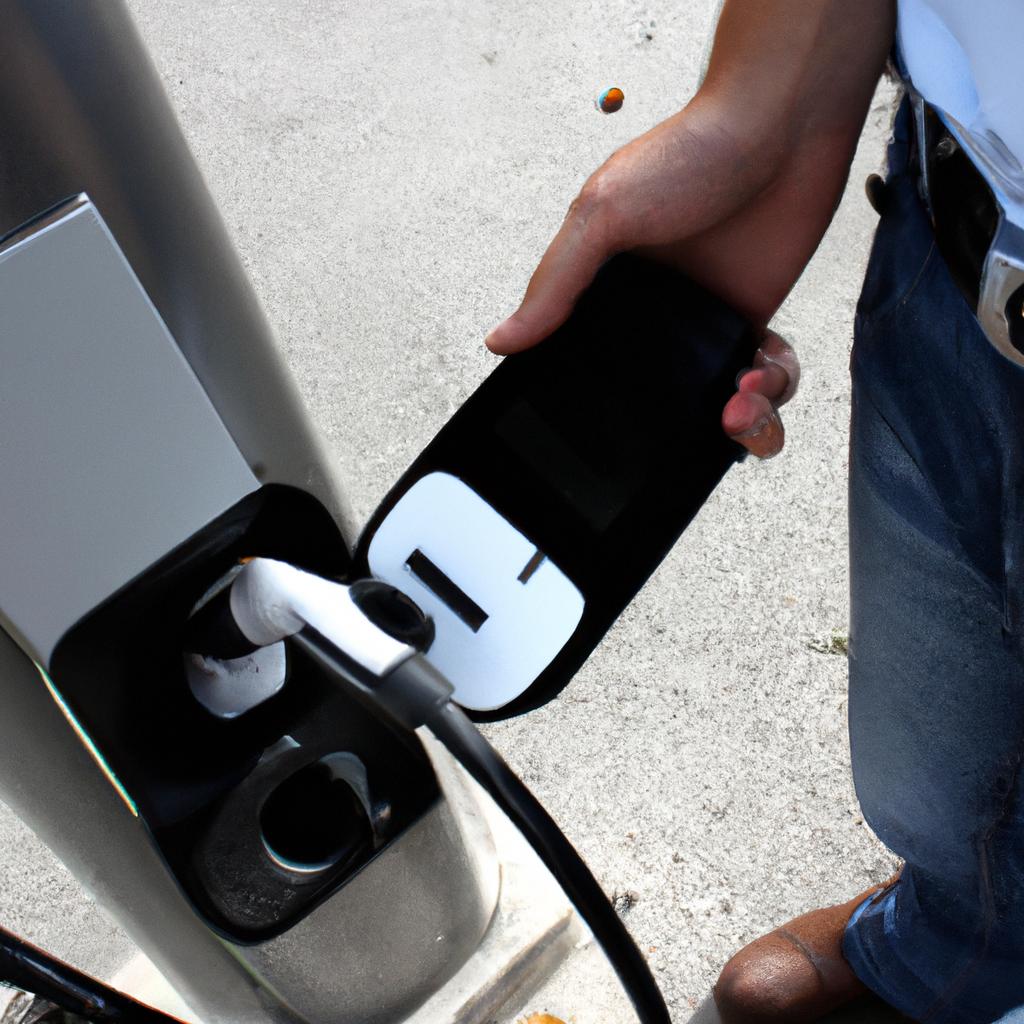Electric vehicles (EVs) have gained significant popularity in recent years as a sustainable and eco-friendly alternative to traditional petrol-powered cars. As the demand for EVs continues to rise, so does the need for an efficient charging infrastructure that can support these vehicles’ growing numbers. One crucial aspect of this infrastructure is the charging connectors used to connect the vehicle to the charger. These connectors play a vital role in facilitating safe and reliable charging, ensuring compatibility between different manufacturers and models.
Consider a scenario where an individual owns two electric vehicles from different manufacturers – one with a Tesla Model S and another with a Nissan Leaf. Both vehicles require recharging after reaching low battery levels during their daily commute or long-distance travel. However, upon arriving at a public charging station, they quickly realize that each vehicle has its unique charging connector type, rendering them incompatible with certain chargers. This hypothetical situation demonstrates the importance of understanding the various types of charging connectors available in electric vehicle charging infrastructure. By exploring these different connector options, we can better comprehend how they affect interoperability among EVs and determine which ones are widely adopted across different regions worldwide.
Type 1 Connector
Electric vehicles (EVs) are becoming increasingly popular as a sustainable mode of transportation. As the number of EVs on the road continues to rise, so does the need for efficient and convenient charging infrastructure. One essential component of this infrastructure is the charging connector, which allows users to connect their vehicles to charging stations.
A common type of charging connector found in EV charging infrastructure is the Type 1 connector. Also known as the SAE J1772 connector, it was developed by the Society of Automotive Engineers (SAE) and is primarily used in North America and Japan. The Type 1 connector features a five-pin design that enables communication between the vehicle and charging station, ensuring safe and reliable charging.
To better understand the significance of Type 1 connectors, consider a hypothetical scenario where an electric vehicle owner needs to charge their car at a public charging station. Upon arrival, they find that all available chargers have Type 1 connectors installed. This compatibility ensures that they can easily plug in their vehicle without any issues or delays.
Here are some key characteristics of Type 1 connectors:
- Compatibility: Designed specifically for Level 2 AC chargers, Type 1 connectors are compatible with most electric vehicles manufactured for use in North America and Japan.
- Safety: The five-pin design includes provisions for ground connection, pilot signal control, proximity detection, and more, ensuring safe operation during charging sessions.
- Charging Speed: While not as fast as DC fast-charging systems, Type 1 connectors can deliver power up to 7.4 kW depending on the capabilities of both the charger and vehicle.
- Availability: Due to its prevalence in North America and Japan, many public charging stations offer Type 1 connectors alongside other types to accommodate a wide range of electric vehicles.
| Characteristic | Description |
|---|---|
| Compatibility | Suitable for most electric vehicles in North America and Japan |
| Safety | Includes multiple safety features for secure charging |
| Charging Speed | Offers power up to 7.4 kW |
| Availability | Widely available at public charging stations |
Moving forward, the next section will explore another commonly used type of connector in EV charging infrastructure: the Type 2 connector. This versatile connector has gained popularity in Europe and is also compatible with various electric vehicle models.
Now let’s delve into the details of the Type 2 Connector without any further delay.
Type 2 Connector
In the previous section, we discussed the Type 1 connector, which is commonly used in electric vehicle (EV) charging infrastructure. Now, let’s explore another widely adopted connector known as the Type 2 connector.
The Type 2 connector, also referred to as Mennekes or IEC 62196-2 connector, is prevalent in Europe and increasingly gaining popularity worldwide. This connector features a larger size compared to its Type 1 counterpart and allows for both single-phase and three-phase charging capabilities. By enabling higher power transfer rates, the Type 2 connector facilitates faster charging times, making it suitable for various EV models.
To illustrate the significance of the Type 2 connector, consider a scenario where an individual owns an electric car with a limited driving range but has access to public charging stations equipped with this particular type of connector. The ability to charge their vehicle quickly using a Type 2 connection would provide convenience and peace of mind during longer journeys.
Here are some key characteristics of the Type 2 connector:
- Compatibility: The majority of modern EVs designed for European markets come with built-in compatibility for the Type 2 connector.
- Versatility: With support for both single-phase and three-phase connections, the Type 2 connector can cater to different power supply configurations.
- Safety Features: Like other connectors in electric vehicle charging infrastructure, the Type 2 variant incorporates safety mechanisms such as ground fault protection and temperature monitoring.
- Charging Speeds: Depending on the available power supply capacity at a given location, vehicles connected via a Type 2 charger can benefit from accelerated charging speeds.
| Characteristic | Description |
|---|---|
| Compatibility | Majority of modern EVs designed for European markets have built-in compatibility with the Type 2 connector |
| Versatility | Supports both single-phase and three-phase connections |
| Safety Features | Incorporates ground fault protection and temperature monitoring mechanisms |
| Charging Speeds | Provides accelerated charging speeds based on the available power supply capacity at a given location |
As we delve into the world of electric vehicle charging connectors, next, we will explore another noteworthy connector type: the CHAdeMO connector. This connector has its origins in Japan and has gained traction globally due to its unique attributes.
CHAdeMO Connector
Types of Charging Connectors in Electric Vehicle Charging Infrastructure
After discussing the Type 2 connector, let us now delve into another commonly used charging connector in electric vehicle (EV) infrastructure: the CHAdeMO connector. To illustrate its significance, consider a hypothetical scenario where an EV owner arrives at a public charging station equipped with a CHAdeMO connector after an exhaustingly long road trip. The driver connects their vehicle to the charger and eagerly awaits for it to recharge.
The CHAdeMO connector is primarily used by Japanese automakers and has gained popularity due to its fast-charging capabilities. Here are some key features and advantages associated with this connector:
- Fast charging: The CHAdeMO connector allows for high-power DC fast charging, making it possible to replenish a significant amount of battery capacity in a relatively short time.
- Compatibility: Many EV models from brands like Nissan, Mitsubishi, and Kia support the use of CHAdeMO connectors, ensuring widespread compatibility within the market.
- International standardization: The CHAdeMO protocol has been widely adopted globally, contributing to its interoperability across different regions and facilitating seamless cross-border travel for EV owners.
- Established network: Over the years, numerous CHAdeMO charging stations have been installed worldwide, forming an extensive network that offers convenience and accessibility for EV drivers.
| Connector Type | Key Features | Advantages |
|---|---|---|
| Type 2 | Slow or fast AC charging | Widely adopted in Europe |
| CHAdeMO | High-power DC fast charging | Popular among Japanese brands |
| CCS | Combined AC/DC fast charging | Gaining traction globally |
As we can see from this brief overview of the CHAdeMO connector, it plays a crucial role in the EV charging ecosystem, offering fast and efficient charging for compatible vehicles. In our subsequent section, we will explore the CCS connector, another important player in electric vehicle charging infrastructure.
Transitioning seamlessly to the next section about the “CCS Connector,” let us now examine its features and advantages.
CCS Connector
Types of Charging Connectors in Electric Vehicle Charging Infrastructure
Following the discussion on the CHAdeMO connector, let us now explore another widely used charging connector in electric vehicle (EV) charging infrastructure – the CCS connector. To illustrate its significance, consider a hypothetical scenario where an EV owner is planning a long-distance road trip and needs to charge their vehicle along the way.
The Combined Charging System (CCS) connector is a standardized charging solution that integrates both AC and DC charging capabilities into one plug. It allows for faster charging speeds compared to traditional AC connectors, making it suitable for high-power applications such as fast-charging stations along highways. In our example, the EV owner can conveniently connect their vehicle to a CCS-compatible charger at a rest stop or service station during their journey, enabling them to replenish their battery quickly and continue with minimal disruption.
To better understand the advantages and features of the CCS connector, here are some key points:
- The CCS connector supports both single-phase and three-phase AC charging, providing flexibility based on available power supply.
- With its combination of Type 1 (SAE J1772) and Type 2 (IEC 62196) connectors, the CCS system caters to various EV models globally.
- The CCS protocol enables communication between vehicles and chargers, allowing for advanced functionalities like automated billing and dynamic load management.
- Many automakers have adopted the CCS standard, leading to widespread availability of compatible chargers worldwide.
Table: Comparison of Key Features Between CHAdeMO and CCS Connectors
| Connector | Maximum Power Output | Communication Protocol |
|---|---|---|
| CHAdeMO | Up to 100 kW | Proprietary |
| CCS | Up to 350 kW | ISO/IEC15118 |
This table provides a brief comparison between the maximum power output and communication protocols of the CHAdeMO and CCS connectors. It highlights the higher power capacity of the CCS connector, making it suitable for fast-charging applications. Additionally, the standardized communication protocol used by CCS enables interoperability among different charging networks and EV models.
Transitioning to our next section about the Tesla Supercharger Connector, we will further explore the unique characteristics and benefits this particular charging connector offers in electric vehicle charging infrastructure.
Tesla Supercharger Connector
Imagine you are on a road trip in your electric vehicle (EV) and need to recharge at a nearby charging station. One of the options available is the Tesla Supercharger Connector, designed specifically for Tesla vehicles. This unique connector offers several advantages that make it an attractive choice for EV owners.
Firstly, the Tesla Supercharger Connector provides ultra-fast charging speeds, allowing drivers to replenish their battery quickly and efficiently. With this connector, charging times can be significantly reduced compared to other types of connectors. For example, a Tesla Model S with a 90 kWh battery can charge up to 170 miles in just 30 minutes using the Supercharger network.
In addition to its impressive charging speed, the Tesla Supercharger Connector also boasts a robust infrastructure across various locations worldwide. The extensive network of Supercharger stations ensures convenient access for Tesla owners during long-distance travel or everyday commuting. This widespread availability contributes to reducing range anxiety and enables seamless journeys without worrying about running out of power.
- Ultra-fast charging speeds
- Extensive global infrastructure
- Convenient accessibility for Tesla owners
- Enhanced driving experience with reduced range anxiety
Now, let’s delve into more specific details by examining these features in a table format:
| Feature | Details |
|---|---|
| Ultra-fast charging speeds | – Reduces charging time considerably |
| – Enables quick replenishment while on-the-go | |
| Extensive global infrastructure | – Wide coverage of Supercharger stations globally |
| – Provides convenience and peace of mind for long-distance travel | |
| Convenient accessibility | – Exclusive compatibility with Tesla vehicles |
| – Easy connection process | |
| Enhanced driving experience | – Alleviates range anxiety |
| – Enables seamless journeys without worrying about battery depletion |
As we can see, the Tesla Supercharger Connector offers a range of advantages. Its ultra-fast charging speeds and extensive global infrastructure make it an appealing choice for EV owners seeking efficient and convenient charging options.
Transitioning to the next section, let’s now explore another type of connector in electric vehicle charging infrastructure: the Wireless Charging Connector.
Wireless Charging Connector
Building upon the discussion of the Tesla Supercharger Connector, we now shift our attention to another crucial aspect of electric vehicle charging infrastructure – wireless charging connectors.
Wireless Charging Connector
To illustrate the significance and potential impact of wireless charging technology, let us consider a hypothetical scenario where a major urban city implements wireless EV charging infrastructure. This case study will shed light on the benefits and challenges associated with this emerging technology.
Benefits:
- Convenience: Wireless charging eliminates the need for physical connection between the vehicle and charger, allowing drivers to simply park their vehicles over designated charging pads or coils.
- Reduced wear and tear: Without constant plugging and unplugging, both the connector ports on vehicles and chargers experience less mechanical stress, potentially extending their lifespan.
- Safety: With no exposed conductive elements during charging sessions, there is reduced risk of electrical accidents such as electrocution or short circuits.
- Aesthetics: The absence of visible cables enhances the visual appeal of parking facilities equipped with wireless chargers.
| Pros | Cons |
|---|---|
| 1. Convenient | 1. Efficiency |
| 2. Safe | 2. Cost |
| 3. Durable | |
| 4. Aesthetic |
Despite these advantages, several challenges hinder widespread adoption:
- Efficiency: Wireless charging systems currently exhibit lower efficiency compared to traditional plug-in connectors due to energy loss during transmission.
- Cost: Implementing wireless charging infrastructure often involves higher upfront costs than conventional options since it requires specialized equipment installation.
While wireless charging connectors offer numerous benefits such as convenience and enhanced safety, their implementation faces obstacles related to efficiency and cost-effectiveness. As technological advancements continue, addressing these challenges and improving wireless charging efficiency will be crucial for wider adoption in the electric vehicle market.
Overall, understanding different types of charging connectors in EV charging infrastructure is essential to ensure seamless integration between vehicles and charging stations. The Tesla Supercharger Connector and wireless charging connectors represent two distinct approaches that contribute to the development of a comprehensive network supporting the growing demand for electric mobility.
 Sfeva
Sfeva



